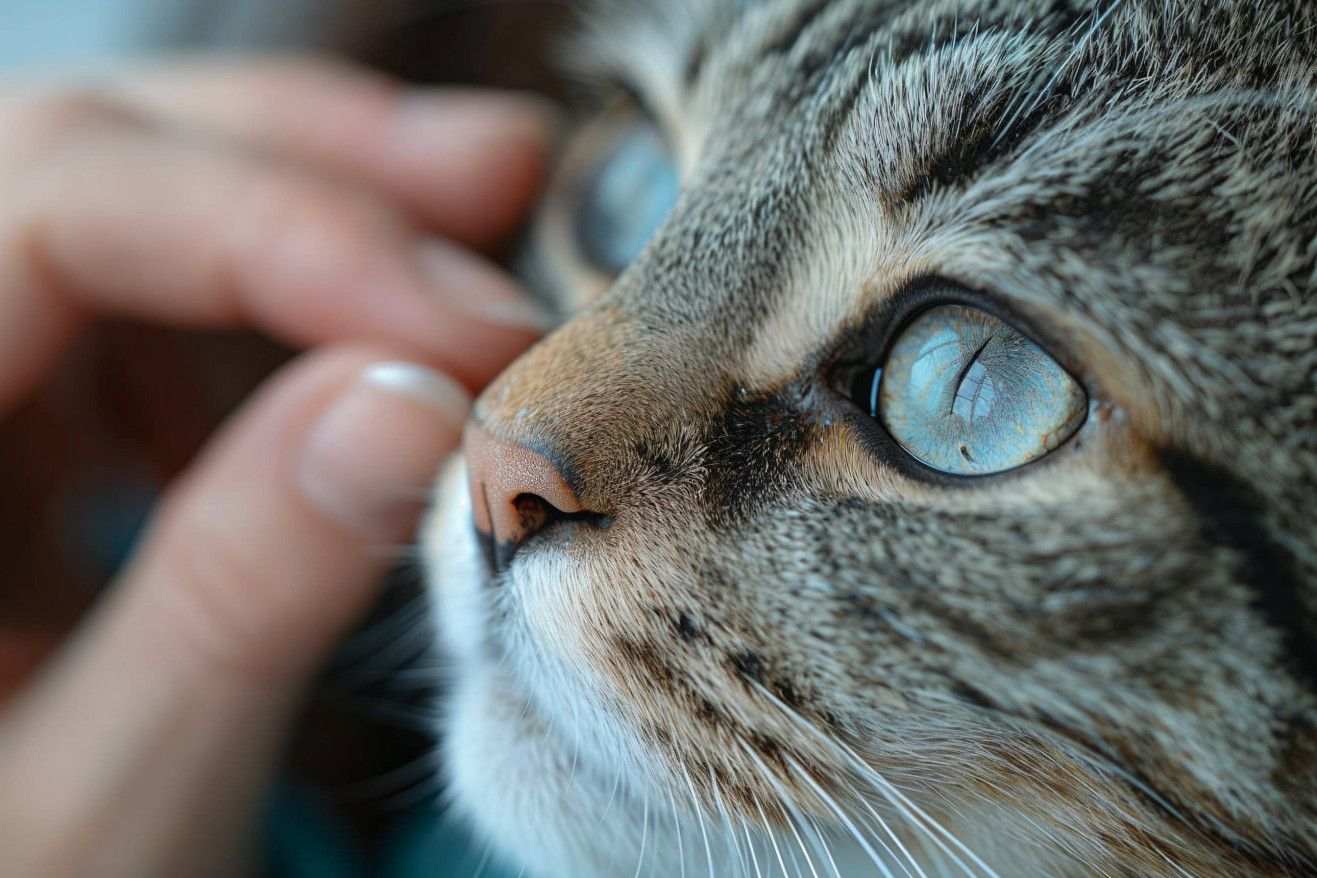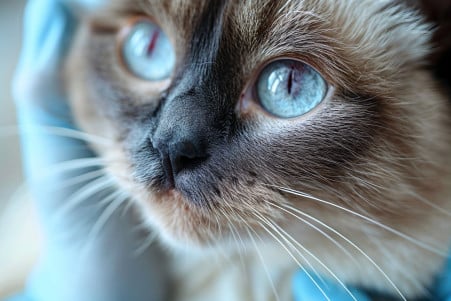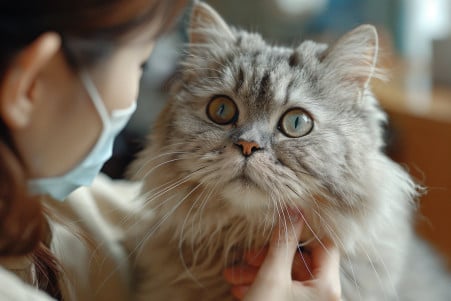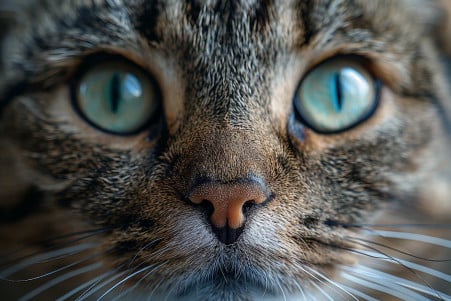What It Means When Your Cat's Third Eyelid Is Showing? Insights and Interpretations
30 April 2024 • Updated 30 April 2024

When you see your cat's third eyelid, don't worry—it's a completely normal part of your cat's anatomy and an important protective mechanism that helps keep your cat's eyes healthy. All cats have a third eyelid, which is also called the nictitating membrane or "haw," in each eye. However, it's usually only visible when a cat is sick, stressed or sleepy because it moves across the eye to protect and moisten the cornea.
To learn more about this unique part of your cat's eyes, we referenced veterinarians and ophthalmologists who specialize in cats. Here, they explain the purpose and role of the third eyelid, and offer advice to cat owners about when they should be concerned about their cat's third eyelid showing and seek medical help. By the time you're done reading, you'll be able to tell when your cat's third eyelid is doing its job and when it's a sign of a medical issue that needs to be treated.
What does it mean when a cat's third eyelid is showing?
Haw's Syndrome: A Common Cause of Third Eyelid Protrusion
Haw's Syndrome is a condition in which a cat's third eyelid, also known as the nictitating membrane, protrudes from both eyes at the same time. This bilateral third eyelid elevation is the main symptom of Haw's Syndrome. Although it's not painful, the protrusion can interfere with a cat's vision if it's severe.
The exact cause is unknown, but there is an association between Haw's Syndrome and gastrointestinal inflammatory disorders or parasitic infections in the gastrointestinal tract. It's thought that the underlying gastrointestinal problems may cause nerve signals to the third eyelid to be disrupted.
Haw's Syndrome is diagnosed through a comprehensive ophthalmic exam that rules out other causes of third eyelid protrusion, such as Horner's Syndrome. The phenylephrine challenge test is often used to diagnose the condition, and if the third eyelids retract after phenylephrine eye drops are administered, the diagnosis of Haw's Syndrome is confirmed.
Luckily, Haw's Syndrome is usually self-limiting and resolves in an average of 47 days, although some cases may last longer. While there is no specific treatment, supportive care is aimed at addressing any underlying gastrointestinal problems through deworming, dietary changes, and ensuring adequate hydration. With time and supportive care, the third eyelids will eventually retract on their own.
Eye Injuries and Infections: Causes of Third Eyelid Protrusion
Eye injuries and infections are common reasons for the third eyelid, or nictitating membrane, to protrude in cats. Per PetMD, trauma is the most likely cause when only one eye is involved, while infections and other illnesses are more likely to be the cause when both eyes are involved. This can range from eye injuries like scratches to a variety of eye infections like conjunctivitis and corneal ulcers.
Because these problems can quickly become more serious if they aren't treated, it's important to get your cat to the vet as soon as possible if you notice their third eyelid is protruding. The Just Cats Clinic notes that any time the third eyelid is showing and doesn't go back to its normal position, it's a sign that your cat needs to be seen by a vet so the underlying issue can be diagnosed and treated. Treatment can range from medications and eye drops to surgery in the most serious cases.
Regular eye check-ups and keeping an eye out for any changes in the eyes or third eyelid are important for keeping your cat's eyes healthy and catching any potential problems early. However, by acting quickly and getting your cat to the vet when you notice their third eyelid is showing, you can help make sure that any problems are addressed before they become more serious and that your cat's eyes stay healthy.
Systemic Health Issues and Third Eyelid Protrusion
Dehydration, fever, or weight loss can all lead to a cat's third eyelid, or nictitating membrane, becoming visible. According to WebMD, this is often a symptom of an underlying systemic health issue affecting the cat.
Gastrointestinal disorders, such as inflammatory bowel disease or parasitic infections, can also cause the third eyelid to protrude. The Spruce Pets explains that this may be due to disrupted nerve signals from the GI problems.
Neurological conditions like Horner's Syndrome can also lead to third eyelid protrusion by damaging the nerves that control the eye muscles. A comprehensive veterinary examination is crucial to identify and treat the root cause of the third eyelid issue.
Diagnostic tests that may be recommended include bloodwork, imaging scans, and specialized eye exams. With a proper diagnosis, the veterinarian can then develop an appropriate treatment plan to address the underlying systemic condition and provide relief for the cat's third eyelid symptoms.
Relief and Home Remedies for Third Eyelid Protrusion
If you're waiting to take your cat to the vet for third eyelid protrusion, there are some things you can do at home to help your pet feel better. WikiHow says that over-the-counter eye drops that contain anti-inflammatory steroids can help reduce swelling and inflammation of the third eyelid. In addition, applying a warm compress to the eye can help soothe the irritation.
That said, make sure that you're not doing anything that could be abrasive or harmful, and always make sure that you're working with a vet to ensure that you're doing the right thing. AristoPet explains that the cause of the third eyelid protrusion needs to be treated and diagnosed by a vet. While home remedies can help with symptoms, they won't fix the problem.
Your vet may also recommend that you make sure your cat is in a comfortable, stress-free environment. It's also important to keep a close eye on the eye to make sure that the symptoms aren't getting worse or that there aren't any other changes. With the right treatment, the third eyelid should go back to normal.
Preventative Care and Keeping Your Cat's Eyes Healthy
Regular veterinary visits and eye exams are important to catch and prevent eye problems in cats early. Rover.com notes that a cat with healthy eyes should only show a small crescent-shaped portion of their third eyelid. If the third eyelid is visible all the time, it's a sign that your cat needs to see a vet.
Proper nutrition and hydration are also important factors in keeping your cat's eyes healthy and preventing third eyelid protrusion. The Spruce Pets explains that controlling parasites and making sure that gastrointestinal issues are treated quickly are important in preventing conditions like Haw's Syndrome.
In addition, keeping your cat's living environment as stress-free as possible can help prevent eye injuries and stress-induced third eyelid protrusion. PetMD notes that if a cat's third eyelid is visible all the time, it's important to see a vet to determine and treat the cause.
Conclusion: Monitor Your Cat's Health
Monitoring your cat's third eyelid is an important part of maintaining their overall health and well-being. While a visible third eyelid is often a normal protective response, persistent protrusion or accompanying symptoms may signal an underlying issue requiring prompt veterinary attention.
From eye injuries and infections to systemic conditions like dehydration or gastrointestinal problems, there are many potential causes of third eyelid protrusion in cats. Addressing the root cause is crucial to resolving the problem and preventing further complications.
Regular check-ups and preventative care measures can help keep your cat's eyes and overall health in peak condition. By staying vigilant and seeking professional guidance at the first sign of any eye changes, you can help ensure your feline friend enjoys bright, healthy eyes for years to come.


